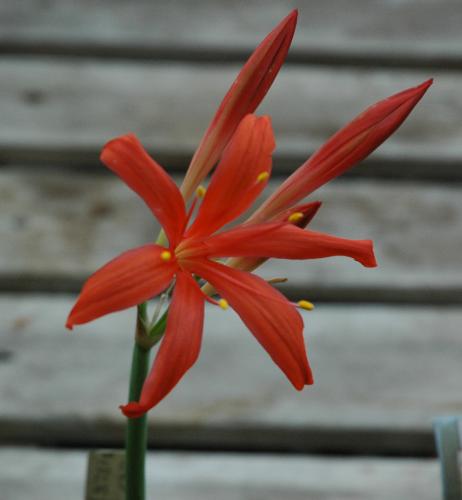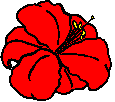
 Shields
Gardens
Ltd.
Shields
Gardens
Ltd.| Home |
| Daylilies |
| Bulbs |
| Clivia |
| Seed Sales |
| E-Mail and Chat |
| Photo Gallery |
| Information |
| Sources |
| Guest Sites |
| Societies and Clubs |
| Links |
| People |
| About Us |
BulbAlert is an occasional e-mail newsletter sent to friends and customers of Shields Gardens Ltd. It contains announcements of bulbs or bulb seeds available for sale at the time of issuance. At other times, it contains notes and news about bulbs of general interest to Bulbophiles. The items reproduced here are from the latter group of newsletters.
To request a subscription to BulbAlert, please send your request, with the e-mail address to which your subscription should be sent, to: Shields Gardens Ltd.We wish you and your families a happy, safe holiday season!
The first complete version of the Hippeastrum Species Database is now posted in the Files section of the Hippeastrum Species Group in Yahoo Groups. You can find it at: http://tech.groups.yahoo.com/group/Hippeastrumspeciesgroup The MS Access database version is more useful than the Excel worksheet version (which latter is still only the preliminary version as of this writing). You have to be a member of the Hippeastrum Species Group on Yahoo to get into the Files section; membership is free.
We grow most of our tender winter-growing bulbs in our cool greenhouse. It has to be kept above freezing at all times. Unlike the big Clivia greenhouse, which is safeguarded by a large natural gas emergency electric generator, the cool bulb house has no emergency power backup. So it was planned to be heated by gas heaters that did not need the electric mains to function. We have two vented millivolt gas heaters and a third, unvented one as backup. The only tricky part in these is the thermopile, which sits in the pilot flame and verifies that the pilot light is lit. When the thermopile malfunctions, the pilot light goes out and of course the main burner valve will not open. We have to replace the thermopile element in at least one of those gas heaters every winter. Today was the day for the first to be replaced this winter. I would insist on having all vented heaters, if we had it to do over again. You need to be able to keep a greenhouse above freezing when the electric power is out, at the coldest temperatures you ever reach. We use gas-fired vented greenhouse heaters made by Southern Burner Company, P.O. Box 885, Chickasha, OK 73023, tel. 405-224-5000. This single pane glass home greenhouse, ca. 12 ft by 24 ft by 10 ft high at the gable peak, needs at least three of these heaters to stay above freezing at outside temperatures around 0°F (ca. -18°C). It gets that cold here at least briefly almost every winter; it can even get colder here. Most winters (until the last half dozen) we have seen lowest temperatures touch -10°F (ca. -23°C) here. [This low temperature defines USDA cold zone 5.] I think that the record low for the last 150 years was -27°F (ca. -30°C), in about 1985.
Unvented gas heaters give off, besides carbon dioxide (CO2), some poisonous carbon monoxide (CO), unburned methane (CH4), and traces of ethylene (CH2=CH2). Ethylene is a natural plant hormone, and it signals the plant to do any of several things: flowers to bloom, fruit to ripen, and leaves to senesce. Long-term, it is deadly for plants in a greenhouse. Never install an unvented gas, propane, or kerosene heater in a greenhouse or any other more-or-less closed space.
I have been planting some of my year-old backlog of Hippeastrum species seeds. A few of my seedling bulbs from seeds planted 3 and 4 years ago were big enough to be potted up individually the past couple of months. I also traded a few of those for some bulbs of rare species I do not have in my collection. Now the weather is no longer suitable for shipping tender plants and bulbs, so I'm just going to tease you with the following:
I added two species to the web page of summer growing bulbs, http://www.shieldsgardens.com/Bulbs/SpringFall.html#hippeastrum Hippeastrum evansiae and H. cybister. I also potted up small seedling bulbs of aglaiae, blossfeldiae, brasilianum, calyptratum, glaucescens, morelianum, petiolatum, psittacinum, and santacatarinum. We have a few seedling bulbs of H. reticulatum form striatifolium, which look like they might be the pure species. This one is common in commerce, but as hybrids. To tell the difference, look carefully at the white midrib stripe on each leaf. the species has a narrow, very sharply defined white line. Hybrids of reticulatum have a broader midrib stripe, more diffuse or sometimes accompanied by some narrower parallel white stripes. The hybrids ought to be a little easier to grow than pure reticulatum striatifolium is. I hope to be able to add some of these species to the web price list page by stringtime.
There are still seeds of several different forms of H. striatum (from Brazil) to be planted, and a variety of fresh seeds on their way here. There are several communal pots of seedlings of Hippeastrum harrisonii (striatum- or vittatum-relative from Uruguay) start in July 2007, thanks to a seed donation someone made to IBS last summer.
With help from Warren Glover in Australia, passed along and supplemented by David Boucher of Hawaii, I'm compiling a database of Hippeastrum species. Eventually, Michael Loos will get his graduate thesis published with a checklist of Hippeastrum species names, but until then I'm working from an unpublished manuscript from R.M. Beauchamp (1984) and from Alan Meerow's paper in 1997. After that sometime (maybe), Alan and Julie Dutilh (Brazil) should publish a revision of the genus Hippeastrum. When that happens, anything we do now will have to be revised extensively. However, I've known Alan since he was in graduate school, and I'm sure we will be able to get a lot of use out of my database before the revision appears -- he's a very busy guy!
The database should be ready to distribute well before the weather warms up enough in spring for us to ship tender bulbs again. The primary version of it will be in Microsoft Access 2000. Parts of it will be made available as a spreadsheet for Microsoft Excel 2000. I have not yet thought it out beyond these preliminary and vague generalities.
Most of you are probably quite well aware that with the mass market folks producing hybrid Hippeastrum ("Dutch Amaryllis"), specialist nurseries like ourselves cannot compete in the hybrid arena. Fortunately, bulb collectors with a more botanical bent was much more interested in the wild species than they are in hybrids. I hope to eventually offer more species over the years.
One problem with many of the wild species is that there are only a few clones in cultivation, and these things are self-sterile. You need pollen from a different clone to produce seed from a flowering Hippeastrum species plant. I was able to do that a few years ago with H. aglaiae, and that is where my seedling bulbs of that species came from. I don't know when my two clones of aglaiae may bloom again together, if ever. H. agaliae is from Argentina, moderate sized funnel form flowers of a creamy white color on a tall scape. Unfortunately I neglected to photograph them when they bloomed the last time. The IBS Gallery of Bulbs has a picture, at http://www.bulbsociety.org/GALLERY_OF_THE_WORLDS_BULBS/index.html then select Hippeastrum from the "H" drop-down menu.
If someone would like to do some trading, I am looking for bulbs of anzaldoi, iguazuanum, leopoldii, lapacense, and fresh clones of evansiae. I'd like to get seeds of argentinum (= candidum, immaculatum, tucumanum) and of parodii. The bulb trades will have to wait for milder weather in spring (March-April-May).
I unpotted some Hippeastrum cybister today, because the pot was too crowded with offsets. This is an unbloomed clone, grown from seed. I'm offering a very few of these offsets at $25 each.
Hippeastrum cybister seedlings, offsets less than 1 inch in diameter. Catalog no. 2177 @ $25.00 each.
We may have a few small seedling bulbs of other species of Hippeastrum later this fall, so watch for announcements in Bulb Alert.
We are sending some Lachenalia bulbs to the Pacific Bulb Society's e-mail BX ("bulb exchange") so watch for those announcements at http://lists.ibiblio.org/mailman/listinfo/pbs (You have to be a paid-up member of PBS to participate in their BX distributions.)
Several years ago, I got a few bulbs of Cyrtanthus montanus from Greg Pettit and Charles Barnhoorn in South Africa. Those have increased, and I've divided the pots. I can offer medium size bulbs of this species, as well as some small but rooted bulbs (not dormant bulbils).
Wide open, rich red flowers, similar to Cyrtanthus elatus and Cyrtanthus sanguineus, but with narrower petals and sepals. There are several flowers per umbel. Short, 5 to 10 inches tall. Deciduous and dormant in winter. These are offsets from bulbs from South Africa. (Image is attached.) Cat. no. 2190 US$12.00 each for medium size bulbs. Cat. no. 2189 US$8.00 each for small rooted bulbs.

There is a plant of Hippeastrum mandonii in bloom in the greenhouse just now. That reminds me to remind you that we have these unusual bulbs. See our web site at:
http://www.shieldsgardens.com/Bulbs/SpringFall.html#hippeastrum
The Crinums are drying off so we can start shipping them too. We again have a very few offsets of Crinum campanulatum and of Crinum lineare available.
Crinum campanulatum is found in seasonal marshes in the Eastern Cape province of South Africa. Tender, The bulb is small, less than 2 inches in diameter and 3 inches long; it produces offsets. The leaves are narrow, 14 to 25 mm wide at the base, and channeled. Deciduous or evergreen, but mainly summer growing. The umbel grows 12 to 16 inches high and bears 4 to 7 small flowers, whose tepal segments are so widened that they form a cup rather than a funnel. Can be grown in a water garden in mild climates. Cat. no. 1453 US$50.00 for offset bulb.
Crinum lineare is native to the Eastern Cape of South Africa. It is a small species with scapes to 12 inches high. Flowers are 3 inches wide and white flushed with red on the outside. Blooms in late summer. Produces offsets. Cat. no. 1448 US$50.00 for offset bulb.
See our web site at: http://www.shieldsgardens.com/Bulbs/SpringFall.html#campanulatum
and http://www.shieldsgardens.com/Bulbs/SpringFall.html#lineare
|
Bulbs-L The independent international list for bulb enthusiasts around the world. This list is private, non-commercial, and not affiliated with any particular society or group. Its remit is geophytes of the world (plants with bulbs, corms, tubers, or rhizomes). We welcome new subscribers. Bulbs-L is hosted by Surfnet in The Netherlands. |
|
International Bulb Society
|
|
Pacific Bulb Society The pbs list is a list sponsored by the Pacific Bulb Society that is open to people around the world who are interested in discussing bulb (more broadly geophytes) with a focus on how to grow them and use them in the garden. This list maintains the pbswiki, an interactive website we can all contribute to, where we show pictures of our plants and ones we have seen in the wild and share brief information about the same. We are interested in all bulbs, tender and hardy. |
|
Great Lakes Bulbs List This group has been replaced by the Bulbs-L list (see above). |
| Australian Bulb Association |
| General Information about bulbs |
|
| Orders: 1-866-449-3344 Toll-free |
|
| International: ++1-317-867-3344 |